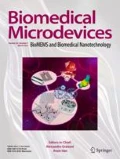Abstract
Here, we developed polymeric microfluidic devices for the isolation of circulating tumor cells. The devices, with more than 30,000 microposts in the channel, were produced successfully by a UV light-curing process lasting 3 min. The device surface was coated with anti-epithelial cell adhesion molecule antibody by just contacting the antibody solution, and a flow system including the device was established to send a cell suspension through it. We carried out flow tests for evaluation of the device’s ability to capture tumor cells using an esophageal cancer cell line, KYSE220, dispersed in phosphate-buffered saline or mononuclear cell separation from whole blood. After the suspension flowed through the chip, many cells were seen to be captured on the microposts coated with the antibody, whereas there were few cells in the device without the antibody. Owing to the transparency of the device, we could observe the intact and the stained cells captured on the microposts by transmitted light microscopy and phase contrast microscopy, in addition to fluorescent microscopy, which required fluorescence labeling. Cell capture efficiencies (i.e., recovery rates of the flowing cancer cells by capture with the microfluidic device) were measured. The resulting values were 0.88 and 0.95 for cell suspension in phosphate-buffered saline, and 0.85 for the suspension in the mononuclear cell separation, suggesting the sufficiency of this device for the isolation of circulating tumor cells. Therefore, our device may be useful for research and treatments that rely on investigation of circulating tumor cells in the blood of cancer patients.






References
M. Alunni-Fabbroni, M.T. Sandri, Methods 50, 289 (2010)
I. Desitter, B.S. Guerrouahen, N. Benali-Furet, J. Wechsler, P.A. Janne, Y. Kuan, M. Yanagita, L. Wang, J.A. Berkowitz, R.J. Distel, Y.E. Cayre, Anticancer. Res. 31, 427 (2011)
M.N. Dickson, P. Tsinberg, Z. Tang, F.Z. Bischoff, T. Wilson, E.F. Leonard, Biomicrofluidics 5, 034119 (2011)
E. Dotan, S.J. Cohen, K.R. Alpaugh, N.J. Meropol, Oncologist 14, 1070 (2009)
G.S. Fiorini, D.T. Chiu, Biotechniques 38, 429 (2005)
J. Hou, M.G. Krebs, L. Lancashire, R. Sloane, A. Backen, R.K. Swain, L.J.C. Priest, A. Greystoke, C. Zhou, K. Morris, T. Ward, F.H. Blackhall, C. Dive, J. Clin. Oncol. 30, 525 (2012)
M. Iwatsuki, K. Mimori, T. Yokobori, H. Ishi, T. Beppu, S. Nakamori, H. Baba, M. Mori, Cancer Sci. 101, 293 (2010)
J. Kaganoi, Y. Shimada, M. Kano, T. Okumura, G. Watanabe, M. Imamura, Br. J. Surg. 91, 1055 (2004)
H.K. Lin, S. Zheng, A.J. Williams, M. Balic, S. Groshen, H.I. Scher, M. Fleisher, W. Stadler, R.H. Datar, Y. Tai, R.J. Cote, Clin. Cancer Res. (2010). doi:10.1158/1078-0432.CCR-10-1105
S. Nagrath, L.V. Sequist, S. Maheswaran, D.W. Bell, D. Irimia, L. Ulkus, M.R. Smith, E.L. Kwak, S. Digumarthy, A. Muzikansky, P. Ryan, U.J. Balis, R.G. Tompkins, D.A. Haber, M. Toner, Nature Lett. 450, 1235 (2007)
C.V. Pecot, F.Z. Bischoff, J.A. Mayer, K.L. Wong, T. Pham, J. Bottsford-Miller, R.L. Stone, Y.G. Lin, P. Jaladurgam, J.W. Roh, B.W. Goodman, W.M. Merritt, T.J. Pircher, S.D. Mikolajczyk, A.M. Nick, J. Celestino, C. Eng, L.M. Ellis, M.T. Deavers, A.K. Sood, Cancer Discov. 1, 580 (2011)
P. Pilati, S. Mocellin, L. Bertazza, F. Galdi, M. Briarava, E. Mammano, E. Tessari, G. Zavagno, D. Nitti, Ann. Surg. Oncol. 19, 402 (2012)
Y. Shimada, M. Imamura, T. Wagata, N. Yamaguchi, T. Tobe, Cancer 69, 277 (1992)
M. Takakura, S. Kyo, M. Nakamura, Y. Maida, Y. Mizumoto, Y. Bono, X. Zhang, Y. Hashimoto, Y. Urata, T. Fujiwara, M. Inoue, Br. J. Cancer 107, 448 (2012)
T. Xu, B. Lu, Y. Tai, A. Goldkorn, Cancer Res. 70, 6420 (2010)
H.K. Zheng, B. Lin, A. Lu, R. Williams, R.J. Datar, Y. Cote, Tai, Biomed Microdevices (2011). doi:10.1007/s10544-010-9485-3
Acknowledgments
This study was supported by Grant-in-Aid for Scientific Research (22500422).
Author information
Authors and Affiliations
Corresponding author
Electronic supplementary material
Below is the link to the electronic supplementary material.
(MPG 8822 kb)
(MPG 30048 kb)
(MPG 8526 kb)
Rights and permissions
About this article
Cite this article
Ohnaga, T., Shimada, Y., Moriyama, M. et al. Polymeric microfluidic devices exhibiting sufficient capture of cancer cell line for isolation of circulating tumor cells. Biomed Microdevices 15, 611–616 (2013). https://doi.org/10.1007/s10544-013-9775-7
Published:
Issue Date:
DOI: https://doi.org/10.1007/s10544-013-9775-7

